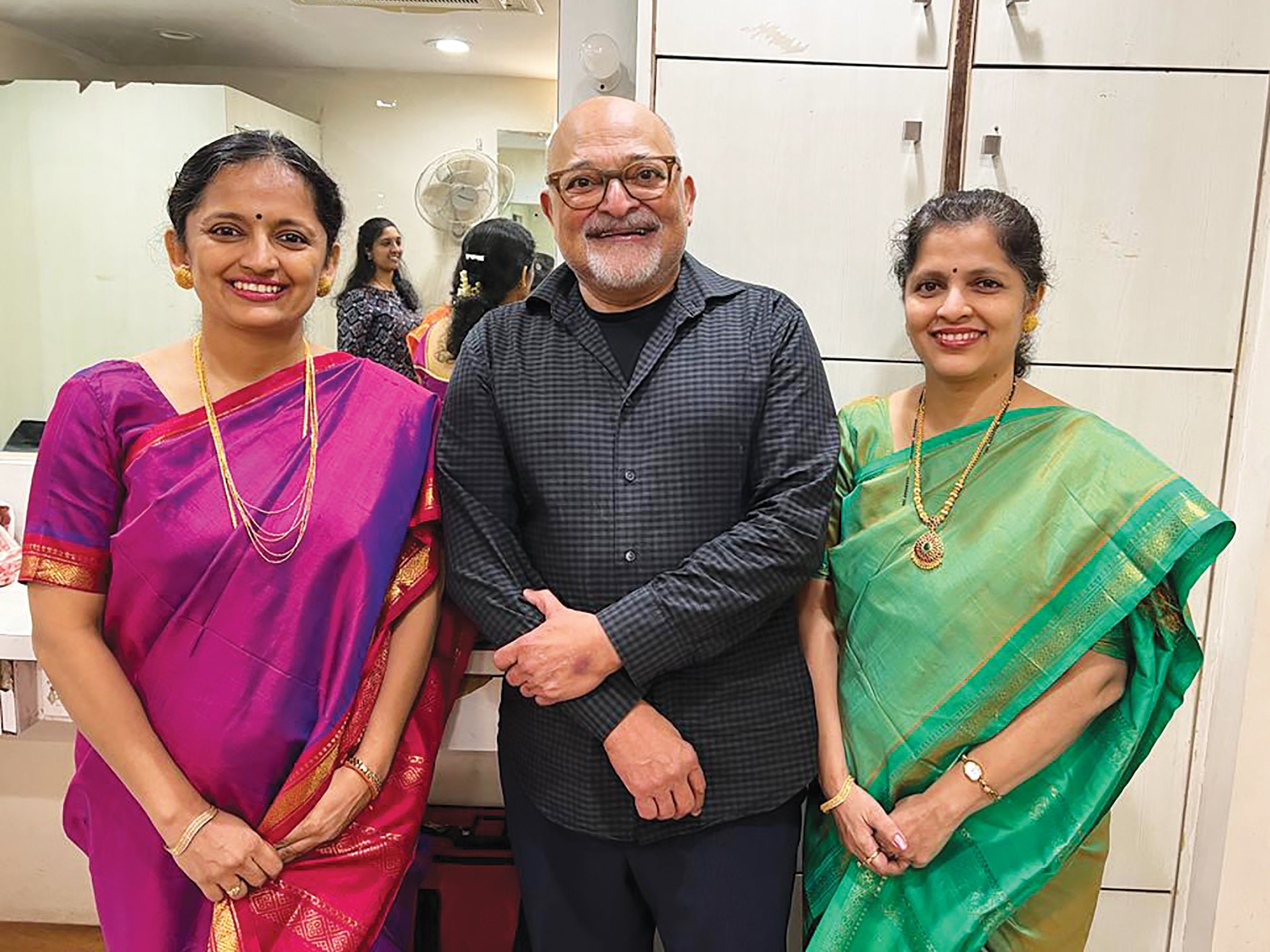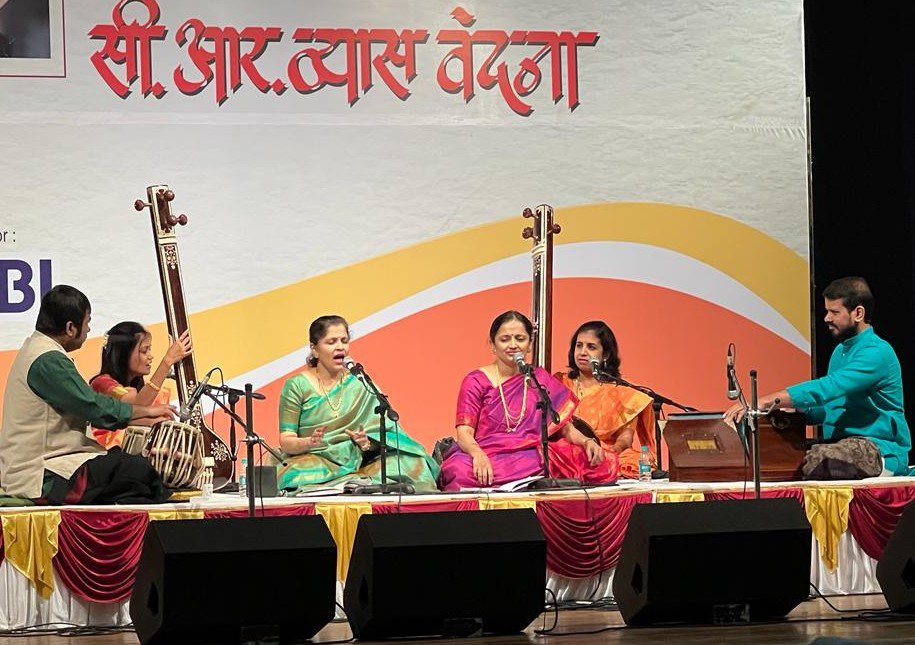SPOTLIGHT
AN EMBARRASSMENT OF RAAG RICHES
Apoorva Gokhale (on the right) and Pallavi Joshi flank Mohamed Khaki.
By MOHAMED KHAKI
India has always held an embarrassment of riches for me – so many cities to visit, so many historic sites to see, and such great food to savour. Increasingly, however, I have been drawn to India more for its music than all the other attractions put together!
The most vivid memory of my first visit in 1988 is of walking around Connaught Circus in Delhi and hearing strains of familiar songs coming from transistor radios that seemed to be everywhere and tuned to the same station – Vivid Bharati, All India Radio. I found out much later that AIR, a government undertaking, was the only radio broadcaster in India until 1993.
Having grown up in Tanzania on a diet of filmi songs broadcast by AIR daily between 4:15pm and 5:15pm, I listened to the songs in Delhi with unexpected nostalgia and an overwhelming sense of belonging.
By then, I had also acquired a deep and abiding love for raag sangeet – Indian classical music – that used to provide the foundational basis for film songs. Even on my first visit, I was determined to attend every concert playing in each city I visited. The only problem was that, despite carrying the most recent edition of the Lonely Planet, the travel bible of most westerners, I felt like I had arrived at Treasure Island without a map.
Where could I find the treasured concerts? Where could I listen to the musical giants of the day?
There was a dearth of information then on live concerts of raag sangeet. The dailies featured front page shenanigans of film stars (still done today, sadly), but scant mention of classical music, which in my opinion is of one of the most sublime offerings that the subcontinent has given to world culture.
Occasionally, tucked in a corner of the entertainment page filled with announcements of filmi blockbusters and promotional gossip, there was an announcement of a performance being held that very day. My plans would have to be recast, based on my singular priority – catching a performance of raag sangeet or dance. Pretty soon, the exercise of scanning dailies before my first cup of chai rewarded me with quite a few worthwhile concerts.
I saw the great Kirana gharana vocalist Gangubai Hangal (accompanied by her daughter Krishna), a performance by the Kathak exponent Urmila Nagar (with tabla accompaniment by Ustad Zakir Hussain, no less), and the budding sarodiyas Ayaan and Amaan Ali Bangash, sons of Ustad Ali Akbar Khan, who must have been in their early teens.
Thankfully, access to live performances has changed dramatically since my first visit, mostly due to the internet and social media. While I had heard of the major festivals like Sawai Gandharva (in Pune) and the Dover Lane Music Conference (DLMC in Kolkata) from aficionados at Raag-Mala concerts in the early ’80s, I now know of other festivals like the Harballabh Sangeet Sammelan that has been held annually in Jalandhar, Punjab, since 1875. In fact, the festival has been livestreaming their performances in the past few years and recordings are still available on YouTube.
Almost a month before the start of my most recent visit, thanks to apps like BookMyShow, I had tickets to see many of my favourite artistes. Within the first two weeks on arriving in Mumbai I had seen Dr Prabha Atre, Begum Parveen Sultana, Vidushi Ashwini Bhide and Pan-dit Venkatesh Kumar, among many others.
The large-scale expansion of air travel within India has made my job as Programming Director at Raag-Mala much easier. India now boasts the third-largest domestic aviation market in the world, contributing 5 per cent to its GDP. I was able to fly from Kolkata to Pune the day after the conclusion of DLMC (where Pandit Ulhas Kashalkar performed in the most prestigious, final early morning spot) to attend the three-day Gangadhar Swarotsav in Pune where I saw younger artistes like Devaki Pandit, Manjusha Kulkarni Patil, Amol Nisal, and the hugely talented sarodiya Abhishek Borkar.
One great pleasure of my job is the personal interaction that I get to have with the artistes, not just when they come to perform in Toronto, but also at home where they live. On my 2020 visit to Mumbai, I was very fortunate to be invited to an informal baithak of afternoon raags by the sisters Apoorva Gokhale and Pallavi Joshi, two exceedingly well-regarded artistes whom I had heard in performance at two Sawai Gandharva festivals.
Born into a family of legendary musicians – their grandfather was late Pandit Gajananbuva Joshi and great-grandfather was Pandit Antubua Joshi, an eminent court musician in the state of Aundh, these wonderful artistes invited me for a private recital, accompanied by their students and talented young tabla and harmonium artistes. What bliss it was to listen to raag Brindavani Sarang on a hot afternoon in Mumbai!
The sisters will perform at the Aga Khan Museum in May, but that did not stop me from attending their performance at the Pandit C R Vyas Vandana in January, where they drew full house on a weeknight. This is what I posted on Facebook after the concert:
Apoorva Gokhale and Pallavi Joshi at the C R Vyas Vandana.
“The sisters complement each other’s singing, without seeming to be over-rehearsed, all the while maintaining spontaneity that is a hallmark of raag sangeet. Best of all, these relatively young singers do not fall into any gimmickry, which sadly is becoming all too common in performances by young artistes these days. Other than a few short phrases, I do not recall any fast sargams, showy taans, etc in their performance. I hasten to add that rapid fire sargams and sapat taans do have a place in raag sangeet... One rarely hears clapping in the middle of my preferred forms of raag sangeet – just some heartfelt “wah!”, “ati sundar!” or even some “aah!”. I suspect I have become snooty in my old age!
“There was a lot of appreciative daad for the sisters’ presentation that night that started with raag Bhopali, the pentatonic raag that continues to amaze me. How can there be such a vast repertoire, from pretty much every gharana, that uses only five notes in the ascending and the same notes in the descending scales? Three bandishes in raag Bhopali were followed by two bandishes in the late night raag Malkauns (again a pentatonic raag). The final item was a beautiful Bhairavi.”
I have little doubt that these superb artistes will bring equal joy to the audience at their live concert.
When and where: Saturday, May 27 at 7:30 pm at the Aga Khan Museum Auditorium, Toronto. Tickets: agakhanmuseum.org.
• Mohamed Khaki is a Raag-Mala Toronto team member.


